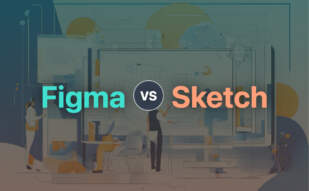
Figma
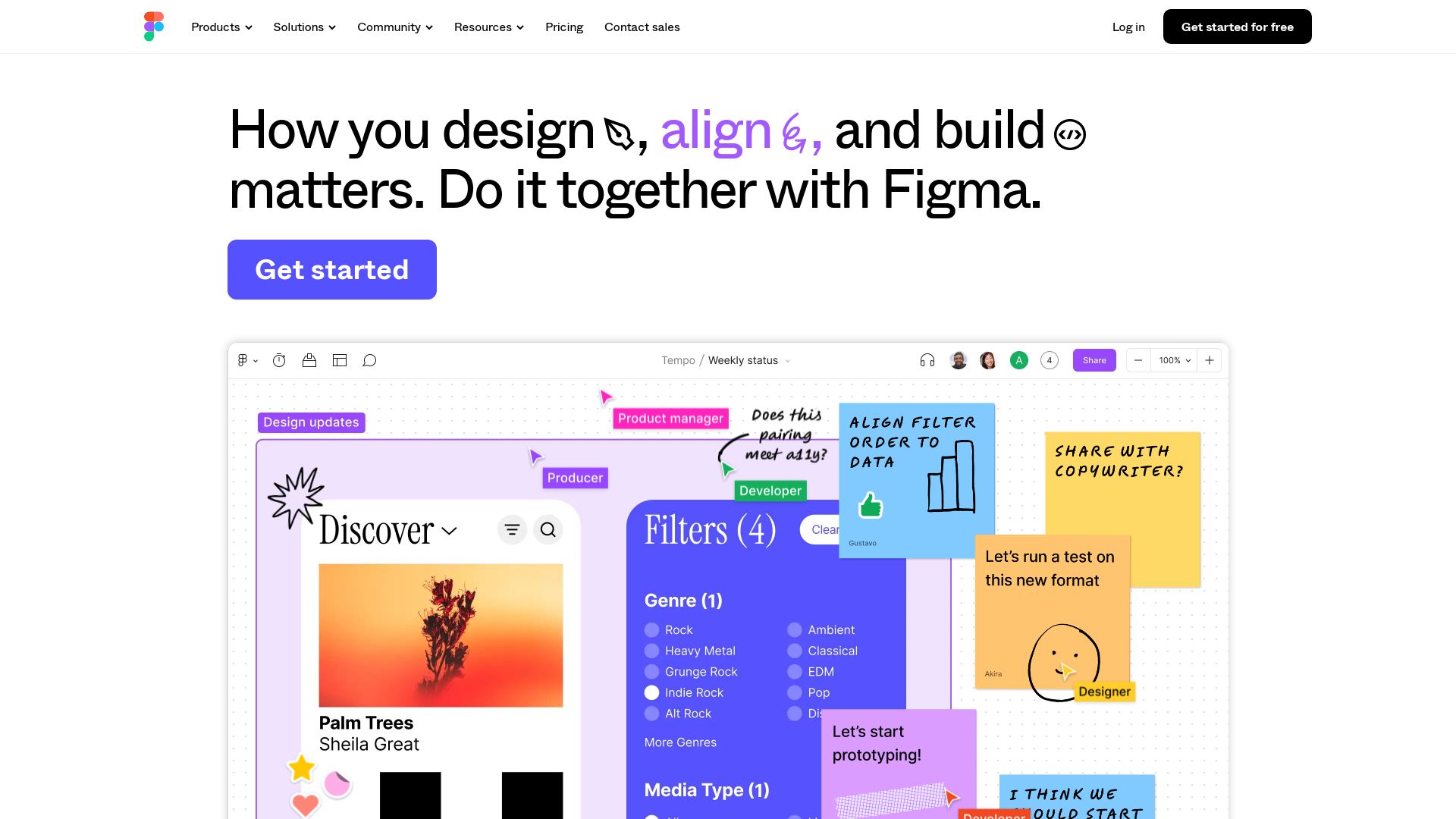
A concoction born in the crucible of Brown University, Figma emerged as a strong contender in the arena of interface design. The brainchild of Dylan Field and Evan Wallace, it was fashioned with an eloquent design philosophy – simplify, democratize, and fuel creativity. Trendsetting features like FigJam and the Figma Community elevated it to a league of its own. However, the tremors of a controversial Adobe acquisition left the tech world pondering over Figma’s future trajectory in the design ecosystem.
Figma Top Features
- Real-time collaboration: Eliminates the chaos of version control, bringing the entire team on the same page.
- Comprehensive Compatibility: Figma is at home, be it on MacBook, Windows PC, Linux machines, or Chromebooks.
- Browser-based design: No special software, no update tussle – Figma lives in your browser.
- Integration capabilities: Courting harmony with Slack for team communication and Zeplin for enhanced CSS display.
| Version control | Automatic and customized versioning gives you the liberty to revisit your designs’ evolutionary journey. |
| Team Libraries | Centralised UI component repository for consistent design output. |
| FigJam – The whiteboard | A multi-purpose digital workspace allowing for brainstorming, planning, and ideas expression. |
Figma Limitations
- Potential forceful integration with Adobe Creative Cloud post-acquisition – a double-edged sword for users.
- Probable changes in the business model could impact users who loved Figma’s pricing strategy, stirring concerns amidst the design community.
Figma Pricing
Figma nails it with flexible pricing attributes – Free, Professional, Organization, and Enterprise plans that meet the needs of different user typologies. The cherry on top – APIs for integrating with browser-based apps.
Figma Use Cases
Use case 1
Project managers can leverage Figma’s real-time collaboration, evading the typical review cycles caused due to late updates and assisting in maintaining coordinated efforts.
Use case 2
Designers relish the power to create, experiment, and iterate without running into version control disasters. Figma’s robust, reliable versioning system acts as a safety net for creativity.
Use case 3
Teams can save time and streamline their workflow by utilizing Figma’s integration capabilities available with other productivity tools such as Slack and JIRA.
Adobe XD

As a fully-fledged user experience design and prototyping tool, Adobe XD offers a theater of possibilities for designing a wide array of digital experiences spanning websites, apps, voice interfaces, and games.
Adobe XD Top Features
- High-quality design: Adobe XD enables creation of high-resolution photography with an Auto-Animate feature for designing engaging web experiences.
- Integration: Adobe XD can seamlessly integrate with Photoshop, broadening the scope for design possibilities.
- Collaboration: It offers features like a shareable URL and comment option that facilitate collaboration within design teams.
- Time-efficiency: Features such as the Repeat Grid enable swift creation of grids, thereby saving significant design time.
- Voice compatibility: Voice command and speech playback features make Adobe XD ideal for designing voice-assisted tools.
| Adaptability | Adobe XD is adaptable to various screen sizes and allows easy adjustment of elements. |
| Mental modeling | The tool is excellent in fostering ‘mental modeling’, a key aspect in fields like online retail. |
| Mobile-friendly | Adobe XD also offers instant viewing of designs on mobile devices, streamlining the design process for mobile apps. |
Adobe XD Limitations
- Despite offering a plethora of features, Adobe XD might seem a bit overwhelming to beginners.
- Lack of certain advanced features compared to some competing UI/UX tools.
Adobe XD Pricing
Adobe XD operates on a freemium model. There is a free starter plan, and paid versions offer expanded features and capabilities.
Adobe XD Use Cases
Use case 1: E-commerce Platforms
Adobe XD effectively allows for the design and prototyping of various interfaces, making it a suitable choice for e-commerce platforms.
Use case 2: Client Dashboards
The platform’s diverse features and high flexibility permit the creation of interactive client dashboards, enhancing user engagement.
Use case 3: Voice-Assisted Tools
With voice command and speech playback features, Adobe XD stands as an ideal choice for designing innovative voice-assisted tools.
Sketch
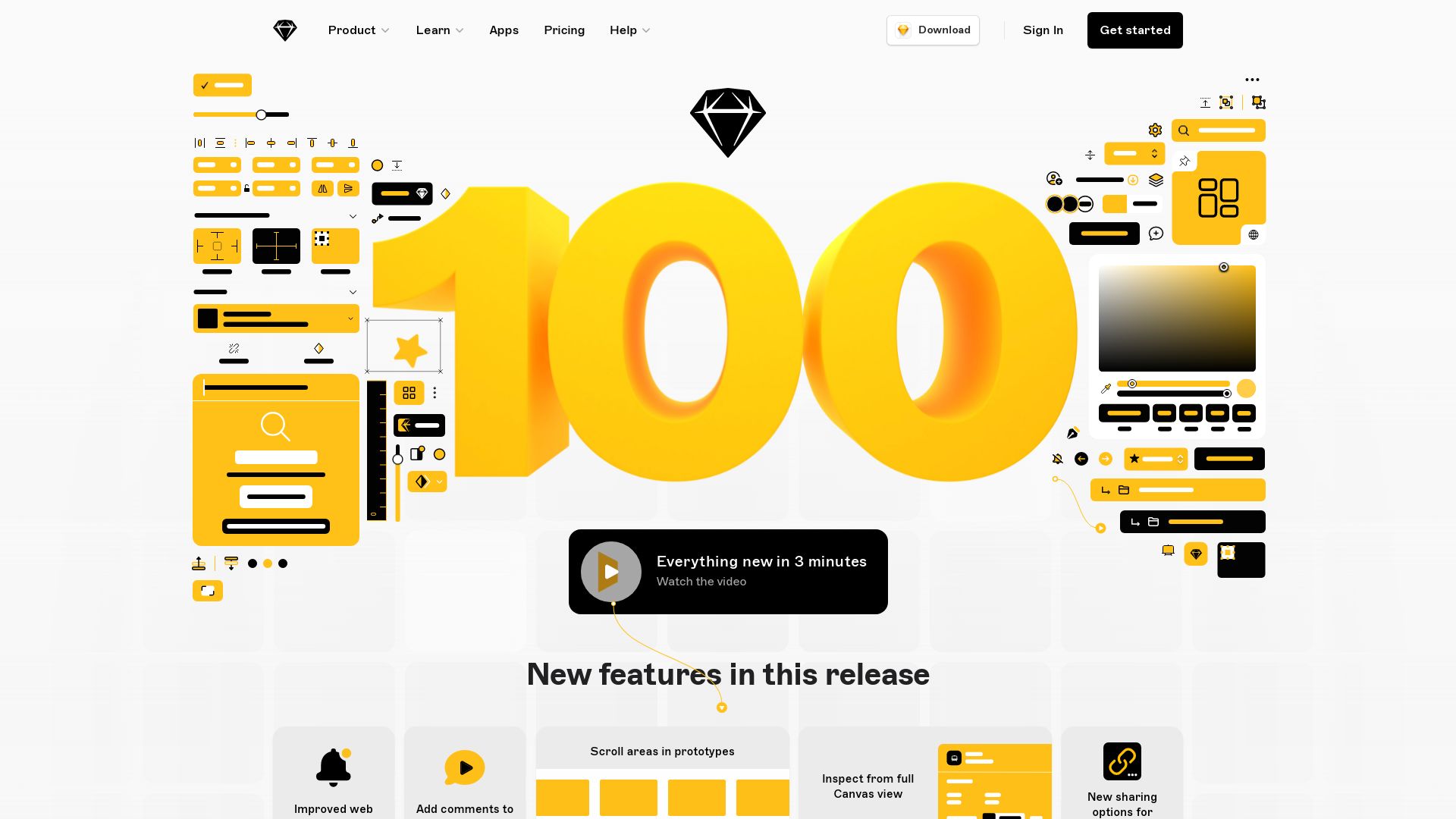
An industry standard, Sketch is a vector-based UI design tool ideal for prototypes, photo editing, and generating mockups. Particularly favored by Mac users, it comes with an easy-to-learn interface and enables precise design and interactive previews for clients.
Sketch Top Features
- Infinite canvas and customizable toolbar
- Artboard for different screen sizes
- High-precision tools: grids, pixel grid, rulers, Smart Guides
- Reusability: In-built text styles and symbols across artboards
- Prototyping Features: Hotspots definition, cross-linking
- Sketch Mirror App for real-time design preview on iPad/iPhone
| Feature | Description |
|---|---|
| RGB to HSB | For better color control |
| Custom Palette Storage | Auto-detection of colors used |
| Simple Vector/Shape Import | Copying and pasting vectors/shapes from Illustrator |
Sketch Limitations
- Only available for Mac
- One device per license
- Collaboration tool limited to Mac Sketch subscribers
Sketch Pricing
Sketch comes with a pricing model of $99 for the first year and $69 for yearly renewal, with volume license available for multiple devices. A free trial of 30-days is offered, followed by a subscription price of $9/month.
Sketch Use Cases
Use case 1: Client-focused Prototyping
For designers who need to consistently share their work with clients, Sketch’s interactive preview facilitates easy collaboration and feedback.
Use case 2: Integrated Design Workflow
Thanks to its compatibility with InVision, Sketch is preferable for teams seeking seamless, integrated design workflows, enabling previews and asset extraction.
Use case 3: Efficient Cross-platform Design
With symbols, reusable features, and template support, Sketch significantly enhances efficiency for designers working on multiple platforms simultaneously.
Webflow
Webflow, known for its eCommerce platform, allows design-led website creation without requiring coding knowledge. Founders Jameel Mohammed and Maximilian Müsgens have created a tool appropriate for various types of products, including physical goods, digital products, and services.
Webflow Best Features
- Customizable product fields, cart, and checkout experiences for a holistic user experience.
- Advanced payment processing systems such as Stripe, PayPal, Google Pay, and Apple Pay.
- Integration with various native interfaces and numerous Zapier apps, along with built-in Google Analytics for insightful data.
- An effective blog feature that can boost SEO efforts and increase customer conversion rates.
- Customizable landing pages, email communication, and secure hosting on SSL domain.
| Additional Features | Description |
|---|---|
| Inventory and Order Management | Inventory sync integrations, order management dashboard, automated tax calculations with applicable sales tax and VAT. |
| Education and Support | Webflow University providing comprehensive tutorial classes, integration with QuickBooks and MailChimp. |
| Sale and Promotion | Sale boosting through integrated coupon codes, promotion boosting integration with Facebook and Instagram. |
Webflow Limitations
- Transactional fees through Stripe can increase the cost of operation.
- Lack of plugins may restrict certain functionalities.
Webflow Pricing
Webflow’s pricing starts at $29 per month when billed annually. The pricing model provides high value through a broad range of design tools and features.
Webflow Use Cases
Use case 1: Web Designers
Webflow’s extensive design capabilities and customizability make it the top choice for web designers. Its prototype feature allows for a seamless transition from design to development.
Use case 2: Online Retailers
For businesses offering physical and digital products, Webflow enables the simplest integration with payment processors, shipment process automation, inventory sync, and more.
Use case 3: Content Creators
Content creators can benefit from Webflow’s CMS, which supports blogging, custom marketing pages, and a host of other features that require no coding knowledge.
Miro
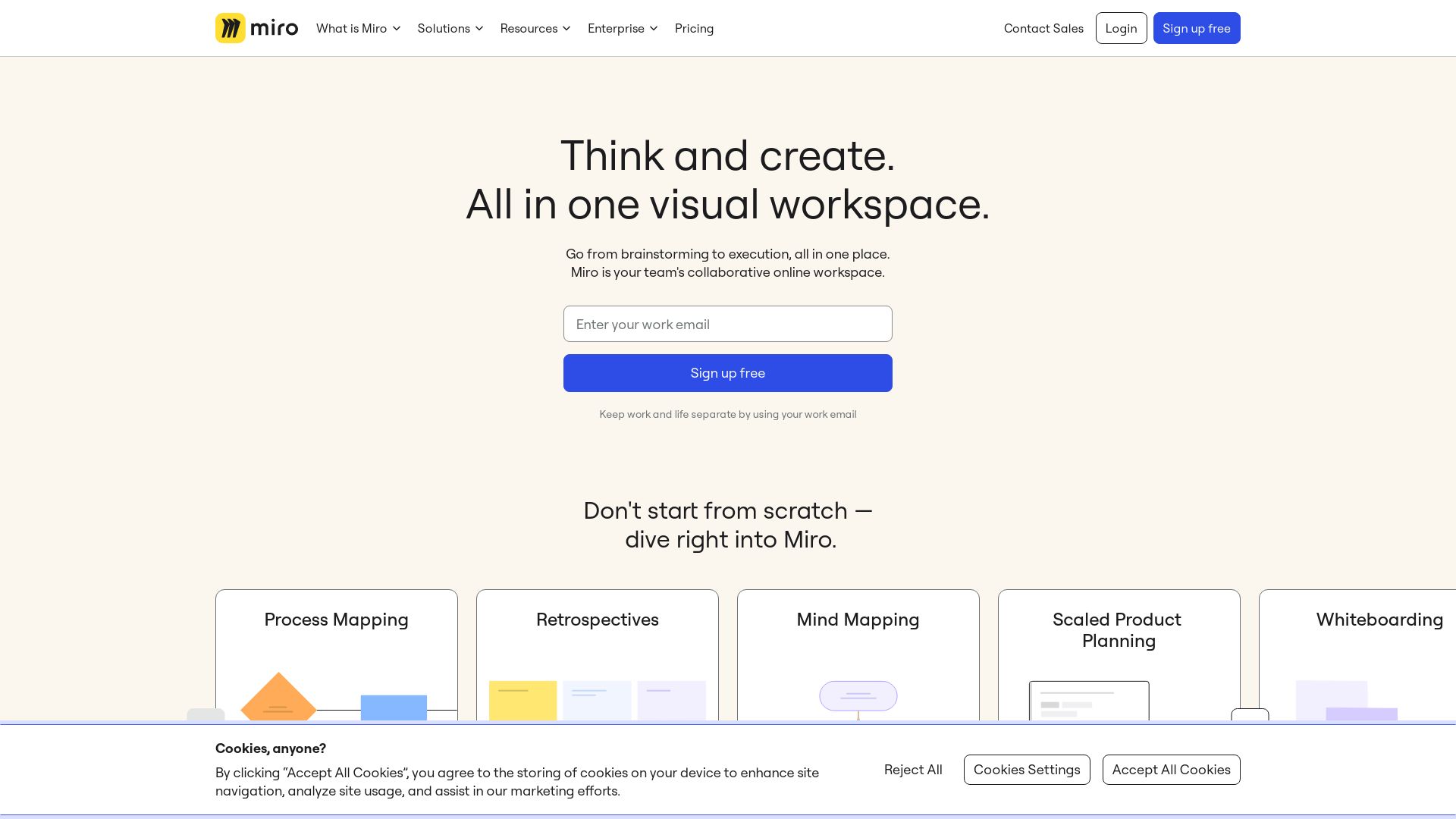
A highly-regarded online collaborative platform, Miro equips both remote and co-located teams with tools for brainstorming, agile workflow management, and increased productivity through some of their impactful integrations, such as with Google Workspace.
Miro Top Features
- 200+ pre-made and customizable templates.
- Real-time collaboration enabled by screensharing and individual cursor identifications.
- Ability to embed or upload items onto whiteboards through drag and drop functionality.
- Miro Developer Platform offers REST APIs, web plugins, and embed options for customized solutions.
| Integrated Platforms | Learning Resources |
|---|---|
| Google Drive, OneDrive, Box, Adobe Creative Cloud, Dropbox, Figma, Adobe XD, Sketch, IconFinder, Unsplash and more. | Dedicated Miro Academy and webinars. |
| Extensions and Integrations | Useful Additional Features |
| Marketplace for apps, integrations and chat platforms to foster communication and enhance functionality. | Voting tool for idea collaboration and timer feature in paid plans to manage time. |
Miro Downsides
- Miro’s free plan is limited to only three editable boards and basic attention management.
- Advanced features like timer and voting tools are offered only in paid plans.
Miro Pricing
Miro offers a free plan with basic features and paid plans with more advanced features and tools ranging from $8 to $20 per month depending on your team’s needs.
Miro Use Cases
Use Case 1: Agile Workflow Management
Miro’s collaborative platform can enhance project management by facilitating real-time brainstorming, tracking progress via smart sticky notes, and enabling efficient agile workflow management.
Use Case 2: Team Collaboration
For remote teams, Miro offers single-board collaboration and screensharing for real-time team collaboration making it an ideal tool for maintaining productivity in a remote work environment.
Use Case 3: Design Processes
Miro is integrated with Champion tools for designers like Adobe XD, Figma, Sketch, offering them a powerful medium for brainstorming and refining ideas on a single platform.
Illustrator
Boasting a comprehensive suite of tools for vector graphics and animations, Adobe Illustrator offers what graphic designers require for creating alluring visuals. From mobile graphics and product packagings to an array of fonts with custom weights, widths, all is part of Illustrator’s plate.
Illustrator Top Features
- Powerful vectorize tool for raster image conversion.
- Radial, grid, mirror repeat enabling sophisticated patterns.
- Blend tool to seamlessly fuse design elements.
- 18,000+ fonts – customizable with the comprehensive type toolkit.
- Effective color and gradient application.
| Feature | Description |
|---|---|
| Integration | Smooth transition and interaction with Photoshop, Fresco; enabled by Adobe Creative Cloud. |
| Syncing and Accessibility | Files synched to the cloud and accessibly from desktop or iPad. |
| Templates | Regularly updated templates for social media, presentations, and more. |
Illustrator Limitations
- May consume resources heavily causing system strain.
- High learning curve, complicated for beginners.
- Although tutorials are available, it requires invested time for learning.
Illustrator Pricing
Illustrator charges $19.99/month for individuals and $29.99/month for businesses. There are no free versions. However, Adobe does offer a 7-day free trial.
Illustrator Use Cases
Use case 1: Pro and Semi-Pro Illustrators
With precision brought by compatibility with Apple Pencil, and a firm foundational toolset, Illustrator is the go-to software for pro and semi-pro illustrators.
Use case 2: Web Designers
Web designers relish Illustrator for its efficient handling of SVG files, PNG, OpenDocument, PDF, PSD file formats for export. Plus, the availability on iPad app and Mac increases its convenience and utility.
Use case 3: Graphic Design
Its reputation as an industry standard for graphic design is backed by features like free-form gradients, shapes, photos, illustrations, and typography. Graphic designers can export their custom banners in JPG, PNG using artboards.
Photoshop
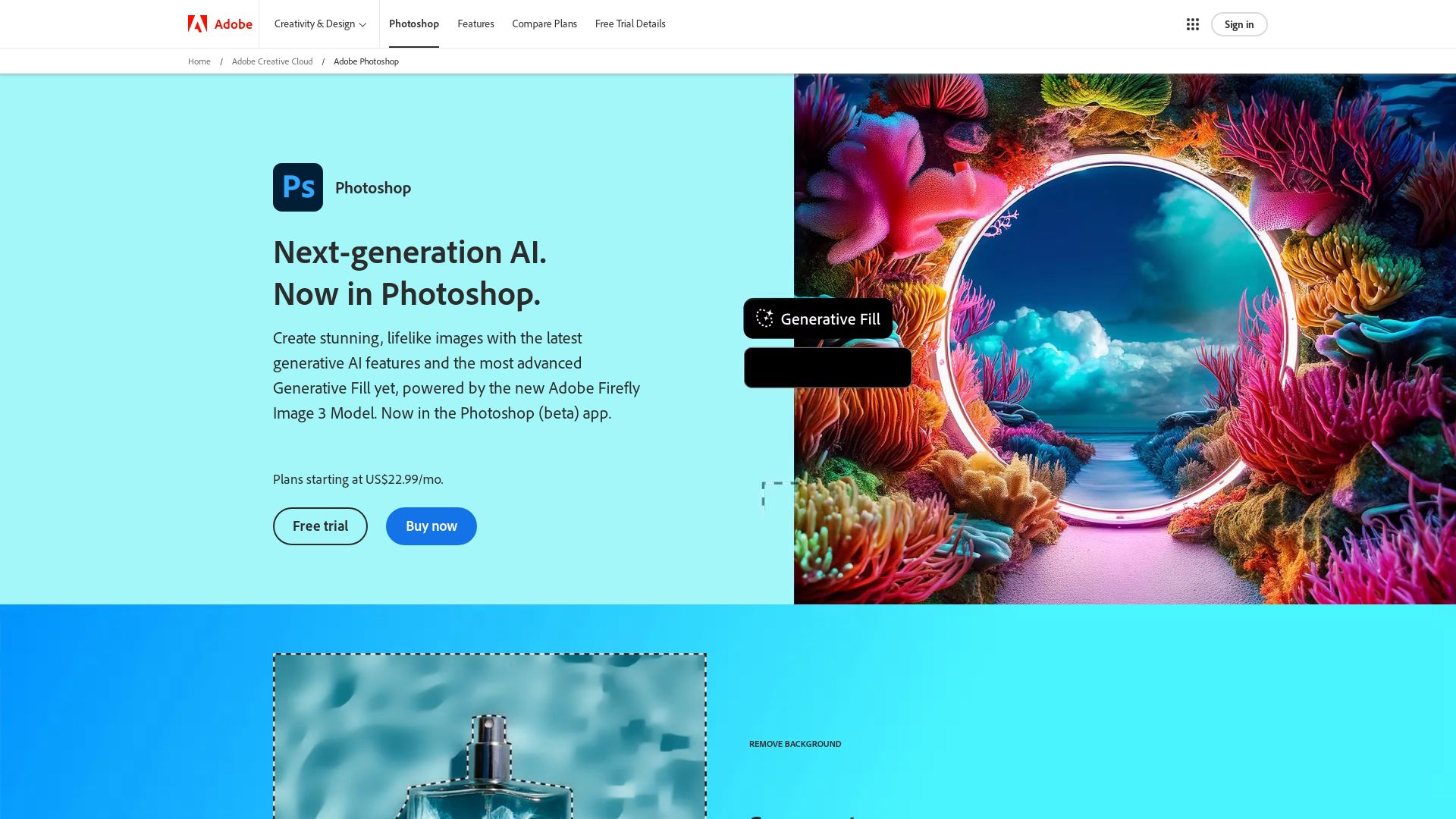
Unleash your creativity with Adobe’s Photoshop, a leading image creation, graphic design, and photo editing software. Developed by Thomas and John Knoll in 1988, it quickly became an integral tool for professional digital art and raster graphics editing. Widely adopted across Macintosh, Windows, and macOS platforms, Photoshop forms a vital part of the Adobe Creative Cloud.
Photoshop Top Features
- Layer-based editing system: facilitates image creation, alteration with multiple overlays, and supports transparency.
- Tools variety: from Clone Stamp, Healing Brush, History Brush, to Blur and Sharpen tools, it has got you covered.
- Advanced features: includes Dodge and Burn tools, and Sponge tool to adjust color.
- PSD and PSB file formats: supports its unique features.
- Latest versions: encompasses updated keyboard shortcuts for paint and brush, enhanced transform warp, and background image removal option.
| Text, vector graphics, 3D graphics, video: | The software is adept at editing and rendering diverse formats. |
| Plug-ins: | Augment the software capabilities, offering new and enhanced features. |
| Adobe Creative Cloud Integration: | Seamless workflow with tools like Adobe Illustrator, Photoshop Lightroom, and Adobe Dreamweaver. |
Photoshop Limitations
- Complex for Beginners: The plethora of features can be overwhelming for beginners.
- Expensive: Could be unaffordable for individual users or small-scale designers.
- Large File Sizes: The PSD files can take up quite a bit of storage space, requiring high-performance hardware to function smoothly.
Photoshop Use Cases
Use case 1 – Graphic Designers
From crafting striking cover art to designing eye-catching posters, Photoshop is the tool for graphic designers. Its vast range of features and brushes allow for complete creative freedom.
Use case 2 – Web Developers
Web developers utilise Photoshop for crafting website designs. It enables remarkable visual effects and user interfaces, ensuring websites stand out.
Use case 3 – Digital Artists
Digital artists create compelling artworks and character designs using Photoshop. With an armory of brushes and layer-based editing, creativity knows no bounds.
Grant Sullivan
Content writer @ Aircada and self proclaimed board game strategist by day, AI developer by night.




